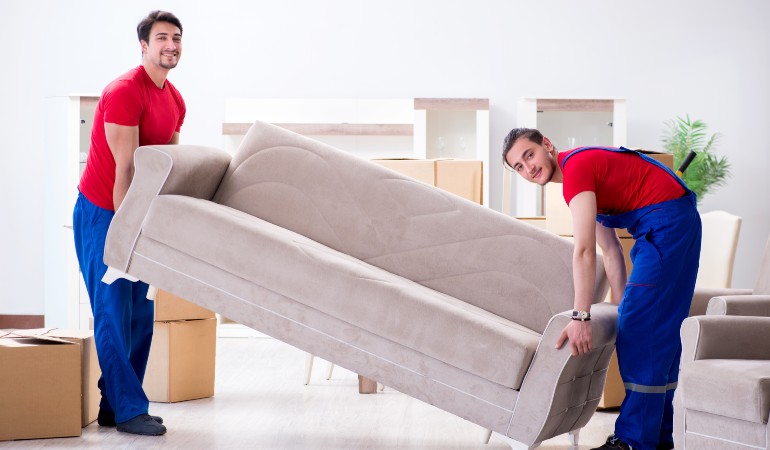
So you’ve decided to store your sofa, perhaps during a move, home renovation, or simply to make more space in your living area. Whatever the reason, storing a sofa properly is essential to ensure it stays in excellent condition and is ready for use when you need it again.
As we walk you through the process of storing a sofa, we will go over the preparation, packing, and choosing the right storage location. With these steps in mind, you’ll be well on your way to safely storing and preserving your furniture.
Table of Contents
What is the best way to store a sofa?
If you are planning to store your sofa in a storage unit, take the following steps to ensure that it remains in good condition throughout the storage period:
1. Clean the sofa
Before storing your sofa, it’s essential to give it a thorough cleaning. Remove any dust, crumbs, or pet hair, and then vacuum the entire surface.
For fabric sofas, consider using a fabric cleaner or upholstery spray to remove any stains. For leather sofas, use a leather cleaner and conditioner to keep the material supple. If you are not sure what your furniture’s material is, it’s best to check the label for information on the material and cleaning recommendations.
2. Disassemble if possible
Sofas can take up significant space, whether you decide to keep it in a storage unit or garage. Therefore, disassembling it can make transporting and storage a lot easier.
A disassembled sofa can fit through narrow doorways, staircases, and tight corners. Also, removing detachable parts reduces the risk of damaging the sofa during the moving process. It will make it less susceptible to dings, scratches, or tears caused by accidental collisions.
We understand that dissembling your piece of furniture may sound daunting, but with some careful planning and the right tools, it can actually be a straightforward task.
All you have to do is follow your sofa’s manual. Start by removing the legs, cushions, and any other detachable parts. Keep all hardware and screws in a labelled bag to ensure nothing gets lost during storage. This extra effort will pay off in the long run, ensuring that your sofa remains in excellent condition for years to come.
3. Wrap the sofa for storage
To ensure the protection of the sofa during storage, you need to wrap it properly. Here is how to correctly cover your couch in a few steps:
- Ensure the sofa’s material is fully dry before using plastic, as any trapped moisture can lead to mould or mildew;
- Use furniture blankets or bubble wrap to provide an extra layer of protection. If you’re storing your sofa in a dry and well-ventilated environment, you can opt to cover it with a plastic sofa cover;
- Secure the wrapping with packing tape to keep it in place. The added layer will safeguard your sofa from scratches and minor bumps during transportation, and also while in storage.
Once stored, ensure the sofa is placed in a way that facilitates airflow and prevents moisture buildup.
Check also:
4. Load and unload the furniture the right way
Loading and unloading your sofa for storage can be a critical phase in ensuring its safety. Improper handling during these two steps can lead to damage, so it’s essential to take the necessary precautions.
A furniture dolly or slider can help you move the sofa without straining your back or damaging the floor. Moving straps can also provide added stability when lifting and moving the sofa.
Sofas can be heavy and awkward to manoeuvre, so it’s advisable to have at least one person assist you with the loading process. More help may be needed for larger or bulkier sofas.
A very important part is to use proper lifting techniques:
- Bend your knees, not your back, when lifting the sofa.
- Keep the sofa close to your body while lifting to reduce strain.
By following these simple loading and unloading tips, you can minimise the risk of damage to the sofa, while also protecting yourself. Proper handling and care during these phases are essential for preserving your health and the quality of your sofa for future use.
5. Store your sofa in the right position
Keep in mind not to store your sofa upright. Doing so for an extended period is generally not recommended, as it can compromise the structural integrity, lead to fabric or leather damage, and cause uneven compression of cushions.
Sofas are designed to support weight and stress in a horizontal position, and storing them vertically may result in long-term issues.
If temporary upright storage is necessary, it’s advisable to minimise the duration and, if possible, disassemble the sofa or store it in a horizontal position to reduce the risk of damage.
6. Ensure easy access to your stored sofa
The accessibility of your storage unit is crucial to make checking and later retrieving your sofa or any other stored items as easy as possible. Proper organisation and thoughtful placement can save you time and effort when you need to access your belongings.
Determine where in the storage unit you’ll position your sofa. If you have other items to store, plan their placement relative to the sofa. Ensure there’s a clear pathway leading to your sofa. This allows you to reach it without having to move other items out of the way.
If your sofa is disassembled, store the components together in a designated area within the storage unit. This way, you can quickly locate and reassemble them when needed. Keep any assembly instructions or documentation with the components.
Are you looking for some space to store your sofa? Fantastic Removals can help!
Enter your postcode to view our rates and availability in your area.
For questions about the services we offer visit our main site or you can always call us at 020 3746 0584
Can you store a sofa in a garage?
If you decide to store your sofa in the garage, it’s essential to take specific precautions to ensure its safety and preservation. We list them all below.
1. Protect the sofa from moisture
The most important thing when storing a sofa in a garage is protecting it from moisture. Garages can be susceptible to humidity, leaks, and temperature fluctuations, which can lead to mould, mildew, and damage to the sofa’s upholstery, frame, and structural integrity. To ensure the sofa remains in excellent condition in your garage, focus mainly on moisture prevention. You can do that by:
- Elevate the furniture off the floor – Use furniture risers, wooden pallets, or other suitable supports to keep the sofa elevated off the ground. This prevents direct contact with potentially damp garage floors;
- Climate control (if possible) – If your garage has climate control capabilities, such as heating or dehumidifying options, utilise them to maintain a stable and moisture-free environment for your sofa;
- Frequent inspection – Periodically check on the sofa for any signs of moisture, damage, or pest infestations. Catching issues early can help prevent further damage and ensure your sofa remains in good condition.
2. Don’t place heavy objects on the sofa
To protect your sofa, avoid placing heavy objects on top of it. Stacking heavy items can lead to damage to the piece’s structure and upholstery. Be cautious of any heavy items stored nearby that could accidentally fall onto the sofa. Secure these items to prevent any accidents from happening.
3. Check for manufacturer instructions
Manufacturers have an in-depth understanding of their product’s construction, materials, and care requirements, making their guidelines invaluable. By adhering to their recommendations, you ensure that you’re taking the most appropriate measures to safeguard your specific sofa.
These guidelines cover a range of factors, from cleaning and maintenance tips tailored to the sofa’s materials to unique storage requirements that may be necessary due to the sofa’s design or components.
Can you store a sofa in a shed?
Just like with garden cushions, storing a sofa in a shed is possible, but there are potential risks and considerations to keep in mind. Sheds are often subjected to temperature fluctuations and humidity, which can affect the condition of the sofa.
Extreme temperatures, especially if they go below freezing, can damage the sofa’s materials, such as causing fabric or leather to become brittle or wood to warp. High humidity can lead to mould and mildew growth, posing a threat to upholstery and causing unpleasant odours.
Additionally, sheds may not provide adequate protection against pests like rodents or insects that could damage the sofa.
If you still decide to store your sofa in the shed, it’s advisable to cover it with a breathable, waterproof cover, elevate it off the ground, and use moisture-absorbing products. Always refer to the manufacturer’s guidelines for specific storage recommendations.
Check also:
How to Properly Store a Freezer When Not in Use
How long can you keep furniture in storage?
Furniture can be stored for both short and long durations if proper precautions are taken. The length of time you can keep furniture in storage can depend on various factors.
Different types of furniture may have different storage requirements. For example, antique or wooden furniture may require more care and attention than modern furniture with synthetic materials.
Properly preparing furniture for storage is crucial. Clean and thoroughly dry items before storing them to prevent mould and mildew. Disassemble furniture when possible, and wrap or cover it with appropriate materials to protect against dust, scratches, and other potential damage.
Choose a secure storage facility with measures in place to prevent theft and damage. If you have concerns or plan to store furniture for an extended period, consider seeking help from storage professionals.
Consult with the professionals
If the task is just too much for you, calling in professionals to advise on best storage practices and help transport your sofa can be a wise decision. That’s important when you want to guarantee the safety and preservation of your valuable piece of furniture.
The removals and storage providers bring a wealth of knowledge and experience to the table, ensuring that your sofa is handled, transported, and stored with the utmost care.
Furthermore, the removalists offer unparalleled convenience, as they take care of every aspect of the storage process, from packing and loading to transportation and unloading.
With professionals handling your sofa storage needs, you can enjoy peace of mind, knowing that your beloved furniture piece is in safe hands.
Your furniture will be stored in excellent condition with Fantastic Removals!
Enter your postcode to view our rates and availability in your area.
For questions about the services we offer visit our main site or you can always call us at 020 3746 0584
Takeaways
- Follow the manufacturer’s instructions for your specific sofa model to ensure proper cleaning and storage;
- Wrapping;
- Protect your sofa from moisture when storing it in a garage by elevating it and using climate control if possible;
- Consider professional removal and storage services for expert care and convenience.














